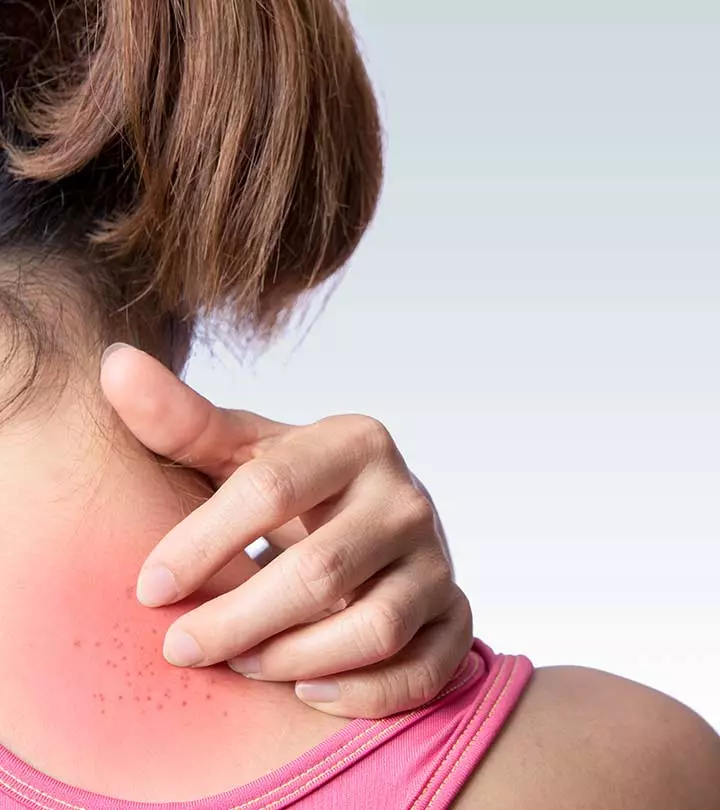Heat rash is a common condition in humid, warm climates. It is more common in children and infants but can also affect adults of any age and gender ( 1). A few different factors in adults cause heat rash. Depending on the style, this type of rash may be inflammatory or non-inflammatory. This article discusses the causes, classes, symptoms, and treatment options for adult heat rash.
What is Heat Rash?
Heat rash can be called many things, including eccrine milaria, sweat rash, or prickly heat. This common condition occurs when the eccrine glands and sweat ducts become blocked ( 1).
These glands are responsible for the majority of sweat produced by the body. The glands are found all over the skin. If these glands become blocked, sweat is redirected back to the epidermis or dermis of the skin. Heat rash occurs under the skin.
The condition is more common in the summer, and a high temperature often accompanies it. What causes the eccrine skin glands to clog up? In the next section, you will learn about three significant causes.
Heat Rash: What Causes It?
- Medical Conditions
Type 1 Pseudohypoaldosteronism is a condition where excessive amounts of sodium are released from the body, leading to its deficiency. The sweat glands are one-way sodium is released. This condition is associated with rubra, a form of miliaria.
Heat rash can also be caused by a rare autosomal-recessive disorder known as Morvan Syndrome.
- Medications
- Certain medications can cause heat rash. Bethanechol and clonidine have all been linked to miliaria. Isotretinoin can also cause heat rash in some cases.
- Bacteria
- Blockages of the eccrine ducts can be caused by bacteria such as Staphylococcus epidermidis. These bacteria can form biofilms, clog glands, and cause sweat to seep through the dermis or epidermis. This can lead to swelling, overhydration, and further blockage. Untreated, this can lead to rupture of the glands and ducts.
- Causes
- Tight clothes, physical activity, and drug patches can also cause blockages of the eccrine glands. Oversweating can lead to a hydration problem in the stratum corneum. This leads to blockages. Sweating excessively is expected when the weather is hot and humid.
- Under pressure, some ducts dilate, causing them to rupture and cause sweat to block the skin. UV exposure can damage epidermal skin cells and cause duct rupture.
Different Types Of Heat Rash (Miliaria)
-
- Miliaria CrystallinaThis heat rash is caused by the blockage of the ducts in the stratum Corneum (outermost skin layer). They can form cysts, which are small liquid blocks in the ducts.
- Miliaria Rubra: This heat rash is caused by a blockage of the epidermis ducts at the subcorneal layer (the skin layer beneath the topmost layer). This can lead to spongiosis, a space in the skin that looks like a sponge. It can cause inflammation in the area of the blocked ducts.
- Miliaria profunda: Blockages between the epidermal and dermal layers (between the papillary layer) cause this heat rash. This condition can also lead to spongiosis in the eccrine gland, similar to miliariarubra.
Heat Rash Symptoms
-
-
- Miliaria crystallina is characterized by superficial vesicles measuring between 1 and 2 mm. The blisters appear as water droplets that are about to burst. The rash usually occurs within a couple of days after exposure to the trigger. It will disappear within one day of the skin’s surface layer being shed ( 1).
- Miliaria rubra, the most common form of miliaria, can be characterized by large red papules or vesicles (1). If pustules appear, miliaria is known as miliaria pustulosa. It may increase the risk of secondary bacterial infection. This can cause inflammation, such as itching and pain. Sweating could make the condition worse.
- Miliaria profunda appears as significant, firm bumps of flesh color not located around the hair follicles. ( 1). These bumps can be extremely itchy or even not at all.
-
- You can now easily distinguish between heat rash and hives caused by allergic reactions. Continue reading to find out how these heat rashes can affect adults.
Heat Rash in Adults
-
-
- Miliaria crystallina can affect adults and children, but usually not before two weeks of age. Most commonly, the upper body, neck, and head ( 1) are affected.
- In adults, miliaria is more likely to be seen in areas where clothing rubs against the skin. This includes the trunk and the extremities. The face is usually spared.
- The box is the most common area affected by miliaria profonda in adults, although the arms and legs can also be affected. Skin rash appears minutes and hours after perspiration and disappears within one hour.
-
Diagnosis of Heat Rash
- Lab tests usually need to be more conclusive. Dermoscopy can be used to diagnose miliaria when people have dark skin. Some doctors may recommend a skin punch biopsy to diagnose a heat rash. A biopsy is not usually necessary for miliaria unless there are some doubts.
Treatment and Management Options
- Miliaria crystallina will usually go away on its own in 24 hours. The miliaria rubra is treated by reducing inflammation. Triamcinolone cream 0.1%, a mild to medium-potency corticosteroid, can be prescribed for one to two weeks ( 1).
- Some cases of miliaria pustulosa can lead to pustules. These bumps tend to be sterile, non-infectious, and sterile. However, secondary infections of Staphylococcus Aureus may occur. Topical antibiotics such as clindamycin may be prescribed in these cases. Combining oral isotretinoin for two months (40 mg/day) with topical anhydrous Lanolin can reduce miliaria profonda( 1).
- You can also follow some tips to prevent and treat heat rash.
-
-
- The skin problem can be treated using antibiotics, antimicrobials, and steroids ( 3). You can also use topical gels, powders, and ointments that contain a cleansing agent. To prevent clogging, the cleansing agent will remove all impurities.
- You may also prescribe cooling, soothing, anti-inflammatory, and antipruritic agents.
- To soothe heat rash, you can use natural remedies such as an oatmeal bath, an aloe vera treatment, a baking soda paste, or a mixture of Fuller’s Earth, Margosa, Fuller’s Earth, Fuller’s Earth, and gram flour.
- Miliaria rubra can be reversed and respond immediately to cooling methods such as air conditioning or gentle fan breezes.
- Vitamin C supplements can help restore normal sweating to stubborn cases.
- Cotton is an excellent fabric for summer clothing. It is lightweight, soft, and absorbent, keeping moisture away from your skin.
- Exfoliate your skin to remove any clogging substances, such as dirt, sweat, and product residue. Exfoliate gently and regularly (once or twice per week).
-
-


